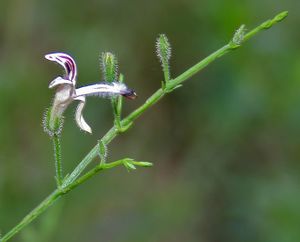Note: This is a project under development. The articles on this wiki are just being initiated and broadly incomplete. You can Help creating new pages.
Andrographis paniculata - Kalmegh
Kalmegh or Andrographis paniculata is an annual herbaceous plant in the family Acanthaceae, native to India and Sri Lanka.It is widely cultivated in Southern and Southeastern Asia, where it has been traditionally used to treat infections and some diseases. Mostly the leaves and roots were used for medicinal purposes. The whole plant is also used in some cases.
Uses
Parts Used
Chemical Composition
Dihydroneobaicalein, andrographidine, andrographidine, andrographidine and, dihydroxy, dimethoxyflavone, beta-D-glucopyranoside, three diterpenoids: andrograpanin, neoandrographolide and andrographolide, two phenylpropanoids, trans-cinnamic acid and 4-hydroxy-2-methoxycinnamaldehyde[1]
Common names
| Language | Common name |
|---|---|
| Kannada | hasi kiriyaatha, kaala megha |
| Hindi | chara-yetah, charayetaah |
| Malayalam | cara-caniram, kiriyat |
| Tamil | anarivempucceti, anariyam |
| Telugu | karivaemu, nela vemu |
| Marathi | NA |
| Gujarathi | NA |
| Punjabi | NA |
| Kashmiri | NA |
| Sanskrit | bhunimba, bhunimbah |
| English | kariyat |
Properties
Reference: Dravya - Substance, Rasa - Taste, Guna - Qualities, Veerya - Potency, Vipaka - Post-digesion effect, Karma - Pharmacological activity, Prabhava - Therepeutics.
Dravya
Rasa
Guna
Veerya
Vipaka
Karma
Prabhava
Habit
Identification
Leaf
| Kind | Shape | Feature |
|---|---|---|
| Simple | Non-Palm Foliage | Foliar Venation is Pinnate / Net and Foliar Margin is Entire, Leaf Area 4.5 (Shrub & Groundcover - Dicot) |
Flower
| Type | Size | Color and composition | Stamen | More information |
|---|---|---|---|---|
| Unisexual | 2-4cm long | Yellow | 5-20 | Flowers Season is June - August |
Fruit
| Type | Size | Mass | Appearance | Seeds | More information |
|---|---|---|---|---|---|
| 7–10 mm (0.28–0.4 in.) long pome | clearly grooved lengthwise, Lowest hooked hairs aligned towards crown | With hooked hairs | {{{6}}} |
Other features
List of Ayurvedic medicine in which the herb is used
- Vishatinduka Taila as root juice extract
Where to get the saplings
Mode of Propagation
How to plant/cultivate
In India, it is cultivated as rainy season (Kharif) crop. Any soil having fair amount of organic matter is suitable for commercial cultivation of this crop. About 400 gms. seed are sufficient for one hectare[3]
Commonly seen growing in areas
Photo Gallery
References
External Links
- Pages that are stubs
- Ayurvedic Herbs known to be helpful to treat cancer
- Ayurvedic Herbs known to be helpful to treat HIV
- Ayurvedic Herbs known to be helpful to treat cough
- Ayurvedic Herbs known to be helpful to treat cold
- Ayurvedic Herbs known to be helpful to treat sinusitis
- Ayurvedic Herbs known to be helpful to treat body pain
- Ayurvedic Herbs known to be helpful to treat Liver problems
- Ayurvedic Herbs known to be helpful to treat leprosy
- Ayurvedic Herbs known to be helpful to treat cholera
- Herbs with Leaves used in medicine
- Herbs with Whole herb used in medicine
- Herbs with common name in Kannada
- Herbs with common name in Hindi
- Herbs with common name in Malayalam
- Herbs with common name in Tamil
- Herbs with common name in Telugu
- Herbs with common name in Sanskrit
- Herbs with common name in English
- Habit - Herb
- Index of Plants which can be propagated by Seeds
- Index of Plants which can be propagated by Cuttings
- Herbs that are commonly seen in the region of Village groves
- Herbs that are commonly seen in the region of roadsides
- Herbs that are commonly seen in the region of waste places
- Herbs




